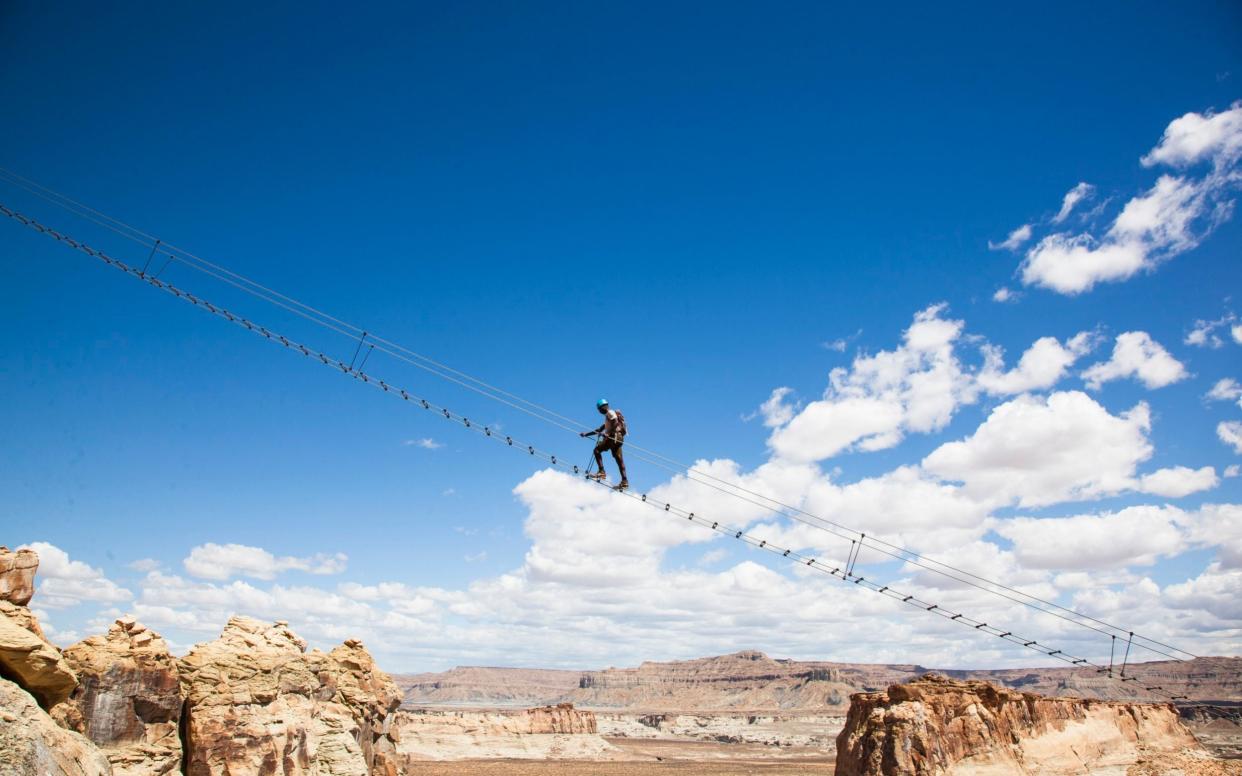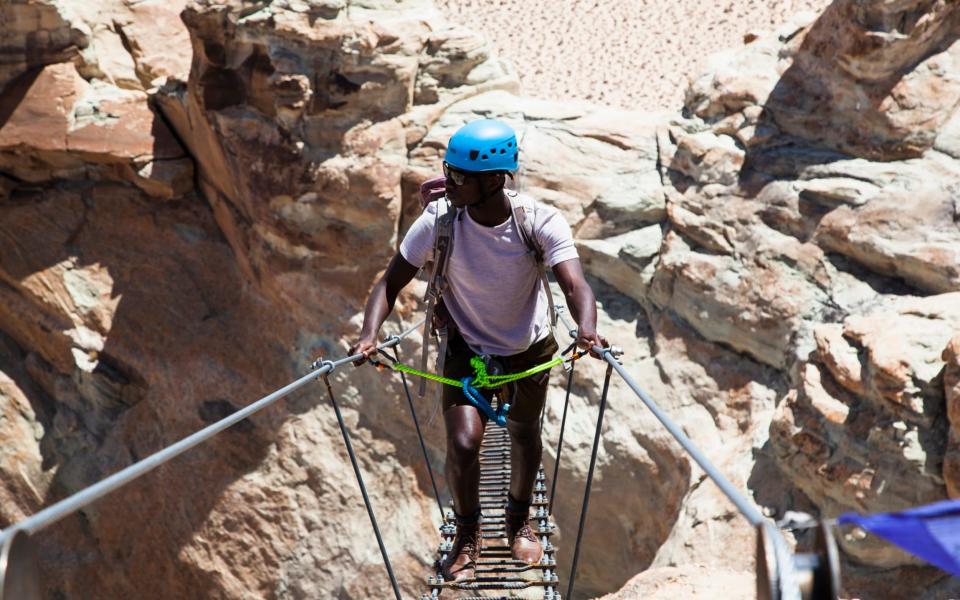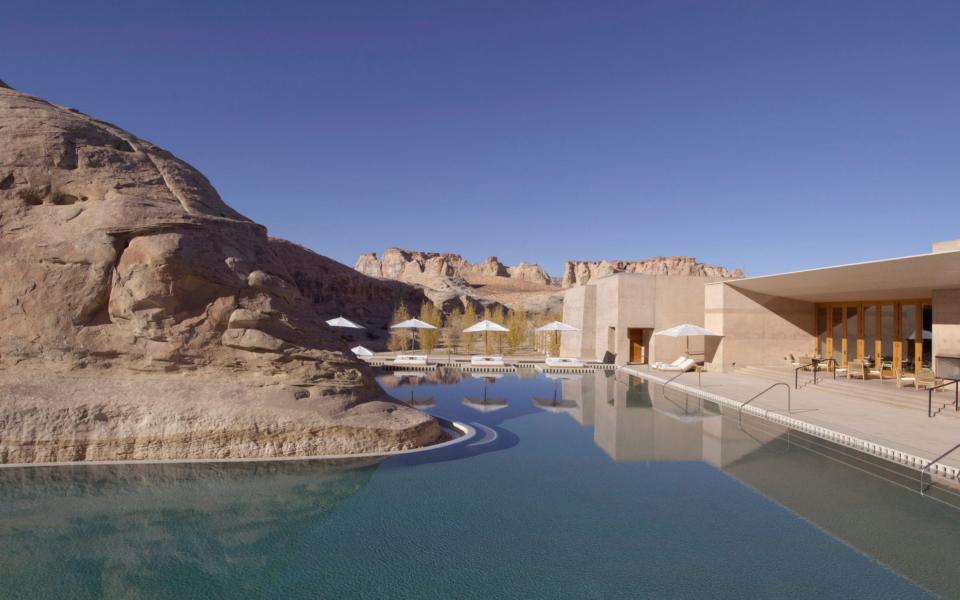What it's like to climb a heart-stopping 'sky ladder', 400 feet above the Utah desert

I had assured myself that the first via ferrata course I completed, the previous summer, would be my last. Via ferratas (Italian for “iron roads”) are climbing routes with metal rungs and cables affixed to mountains and other rock forms. My “rock” was a 160 million-year-old, 100-metre-tall mesa cliff face at Amangiri, an ultra-luxe desert retreat in southeastern Utah beloved by superstars and low-key billionaires. It was a thrill, surely, to do a guided climb on an exclusive property and reward myself with vast vistas of desert and canyonland at the top… but my ascent of the Hoodoo Via Ferrata was also riddled with thoughts that my clumsy feet and jittery hand grips would result in a stay in an emergency room rather than back at my luxurious accommodation.
This April, Amangiri unveiled another new guests-only attraction for the adventurous: the Cave Peak Stairway, a wiry, 120-step “ladder” accessed at the top of two via ferrata courses, with the higher end hovering 100 metres above scorched earth. The sight is knee-buckling, to say the least, but I guess the inner daredevil in me wanted to return and give one of the world’s longest via ferrata ladders – spanning 61 metres – a go.

“Walking the stairway is 75 per cent mental and 25 per cent physical,” says Wryht Short, the private guide for me and my mildly heights-averse friend Corey, as we approached the base of the Cave Peak Via Ferrata. We took about 15 minutes to step into our climbing gear – helmets and lanyards with carabiners fashioned at our waist – and learned the ropes of scaling the via ferrata safely. The two elastic cords with carabiners were my lifeline; Short emphasised clamping one auto-lock carabiner at a time on to each cable segment of the vertical course, because if I was not tethered and suddenly lost control, I’d be lunch for the buzzards.
What Short didn’t mention at the time was the mental-to-physical ratio of the via ferrata climb itself, and based on my previous experience with the Hoodoo Via Ferrata, I’d say it’s 50/50: this is the most time-consuming aspect (most of Amangiri’s courses, like the Cave Peak, run three hours; I’d advise limiting liquid consumption beforehand), the most varied, and the most physically challenging.
Eventually we were on the up and up, and it didn’t take long for me to appreciate my two-metre-tall frame and the limbering yoga session I did the day before, as I lunged for rungs to hoist me higher. “I’ve seen shorter people do all kinds of creative things to make their way up or down,” says Short, who has been a via ferrata guide and route creator at Amangiri for eight years.
After a repetitive series of clamping, climbing and looking up, down and around, we made it to the top. I stood underneath the stairway and glanced upward to see nothing but cerulean sky and a sharp, inclined ladder silhouette that swayed with the breeze.

My previous via ferrata course, at the peak, had two flat suspension bridges to traverse. This time I braved tightrope-thin steps and a height change of 31 metres from the ladder’s lowest and tallest points high above the canyon. I took it slow, going step by step and learning that keeping each foot in the middle will prevent the unnerving wobbling. The ascent was surprisingly peaceful, with only the sound of my breathing and the zipping friction of the hooks and cables breaking the desert silence. When I felt my feet had good traction, I took time – with a death grip on the railing – to look around and enjoy the bright midday views. There was Lake Powell in the distance; the green canvas roofs of Camp Sarika, Amangiri’s new tented glamping resort, which opened last July; and the magnificent site of Grand Staircase-Escalante National Park, breaking the horizon to the right.
I eventually made it to the top of the stairway, where a colourful strip of Nepalese prayer flags (like the ones you see on Himalayan climbs) marked my vertiginous achievement. I took even more time to scan the landscape filled with speckles of sagebrush, buttes, and dusty-pink entrada sandstone.
We made our way down the same way we came up, and returned to our resort suite, unscathed but with wobbly legs for about two hours.
Taking on the Cave Peak Stairway was a thrill, and I was glad I pushed myself to do a second via ferrata climb. I think I’ve reached my adventure quota for a few months, so I’ll be keeping my feet on solid ground for a while.
The details
Three-hour Cave Peak Via Ferrata and Stairway costs $780 (£550) for two, excluding taxes and service charge. Available daily to overnight guests at Amangiri and Camp Sarika (aman.com), where nightly rates start at £1,482 and £2,470 respectively, including all meals, non-alcoholic drinks, and transfers from Page Municipal Airport. Overseas holidays are currently subject to restrictions. For more ideas on where to stay, see our guide to the best hotels in Utah.

